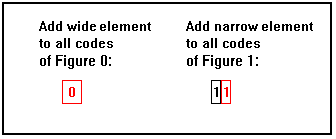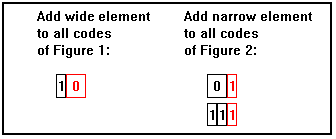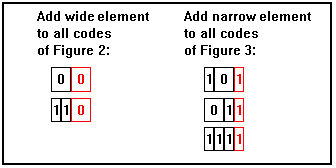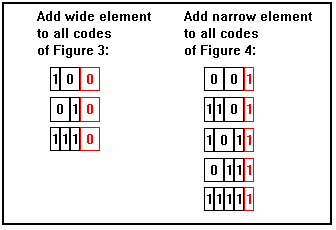

Consider a code in which a binary "1" is
represented by a narrow element, and a binary "0"
is represented by a wide element. Call the length of the
narrow element a "cell". Further, assume the wide
code element, representing binary "0", is exactly twice
as long as the narrow code element, so that it is two cells
long.
Now: How many different codes can fit in a space
exactly "N" cells long? To answer this question, let's
start writing them down, remembering that a "0" is two
cells long. We will build longer codes from shorter ones by adding
on the right.
Clearly, there is only one way of selecting a codeword
of zero length (the NUL codeword, with no elements), and there
is only one codeword of length 1, which is the codeword "1".
For all codes of 2 cells or more, we can construct all
the possible codes of any particular length
by adding a wide "0" element to all
of the codewords that are two cells shorter, and by adding a narrow
"1" element to all codewords that are one cell shorter.
See the following Figures:
|
Figure 0: All codes of length 0 cells
(none) |  |
|
Figure 1: All codes of length 1 cell |  |
|
Figure 2: All codes of length 2 cells |  |
|
Figure 3: All codes of length 3 cells |  |
| Figure 4: All codes of length 4 cells |  |
| Figure 5: All codes of length 5 cells |  |
That is, the following two rules have been used:
all codes of length N can be constructed by:
Rule B: Append a "1"
(which is always one cell wide) to all codes
of length N-1 (codes constructed this way are shown in the right
column in the Figures)
Note that the words "all codes"
in the rules include the codes in both columns of the
earlier Figures.
Now, back to the initial question: How many
codes are there? Note that we can consider that there is exactly
one code of zero length, the NUL (or "empty") code,
and exactly one code of length 1. For length 2 or greater, following
the generation rules above, the number of codes of length N is
obviously the sum of the number of codes of length N-1 (rule B)
plus the number of codes of length N-2 (rule A). In other words,
the lengths form a series of numbers beginning with 1, 1, ....
and in which each number is the sum of the previous two:
| Length: | 0 | 1 | 2 | 3 | 4 | 5 | 6 | 7 | 8 | ... |
| No. of codes: | 1 | 1 | 2 | 3 | 5 | 8 | 13 | 21 | 34 | ... |
This, however, is the well-known "Fibonacci"
series, named after the greatest European mathematician of the
Middle Ages, Leonardo of Pisa, better known as "Fibonacci",
"son of Bonaccio." It was first mentioned in his book
Liber abaci ("Book of the Abacus"), published
in the year 1202. These numbers are traditionally denoted by a
subscripted capital "F", as follows:
Fibonacci Number: F1
F2 F3
F4 F5
F6 F7
F8 ...
Value: 1
1 2
3 5
8 13
21 ...
And so, the answer is (Tah Dah!):
The number of different codes that are exactly
N cells long is equal to FN+1, where FN represents the Nth Fibonacci
number.
Click here to return to Larry Krakauer's home page
Click here to return to the starting Fibonacci Code page